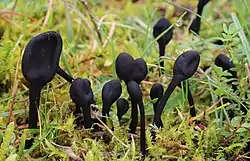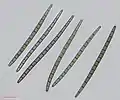Trichoglossum hirsutum
Trichoglossum hirsutum is a species of fungi in the family Geoglossaceae. They are commonly called black earth tongues.
| Trichoglossum hirsutum | |
|---|---|
 | |
| Trichoglossum hirsutum | |
| Scientific classification | |
| Kingdom: | |
| Division: | |
| Subdivision: | |
| Class: | |
| Order: | |
| Family: | |
| Genus: | |
| Species: | T. hirsutum |
| Binomial name | |
| Trichoglossum hirsutum (Pers.) Boud. 1907 | |
Description
Trichoglossum hirsutum makes a black club shaped fungus 3–8 cm high. The cap is usually 1–2 cm tall.[1] The spores are produced on the enlarged upper part, which is 5–8 mm wide, up to 2 cm high, flattened, spearhead-shaped to ellipsoid and finely velvety. The flesh is thin, tough and brownish. The stem is up to 6 cm long and 1–4 mm thick, cylindrical and velvety.[1] Spores are 80–195 x 5–7 micrometers, cylindric-clavate, broadest in the middle and tapering to the blunt ends, with 15 septa. The asci each have 8 spores. The paraphyses are brown, cylindrical and coiled at the tips.[2]
The species is inedible.[1]
Systematics
Trichoglossum hirsutum was first described as Geoglossum hirsutum in 1797 by Persoon. In 1907, Jean Louis Émile Boudier published it as Trichoglossum hirsutum.[3]
The epithet hirsutum (Latin: 'hairy tongue') refers to the fine hairs that cover the fruit body.[4]
Location
Trichoglossum hirsutum is found in woodlands in North America, Europe, Macaronesia[5] and Africa.[6] It is listed as an endangered species in Lithuania.[7]
Similar species
Trichoglossum walteri is similar but has spores 50–115 micrometers, with 7 divisions.[8] Geoglossum fallax and Microglossum viride are also similar.[1]
Gallery
 Trichoglossum hirsutum stipe
Trichoglossum hirsutum stipe Trichoglossum hirsutum
Trichoglossum hirsutum Trichoglossum hirsutum spores 400x phase contrast
Trichoglossum hirsutum spores 400x phase contrast Trichoglossum hirsutum spores 400x brightfield
Trichoglossum hirsutum spores 400x brightfield
References
- Davis, R. Michael; Sommer, Robert; Menge, John A. (2012). Field Guide to Mushrooms of Western North America. Berkeley: University of California Press. pp. 389–390. ISBN 978-0-520-95360-4. OCLC 797915861.
- "Trial field key to CLUB-SHAPED FUNGI in the Pacific Northwest".
- "Index Fungorum - Trichoglossum Genus".
- Trudell, Steve; Ammirati, Joe (2009). Mushrooms of the Pacific Northwest. Timber Press Field Guides. Portland, OR: Timber Press. pp. 242–243. ISBN 978-0-88192-935-5.
- Richard P. Korf (1981). "A preliminary discomycete flora of Macronesia". Mycotaxon (13): 361–366. ISSN 0093-4666.
- Clovis Douanla-Meli & Ewald Langer (2005). "Notes on Discomycetes: New species and new records from Cameroon". Mycotaxon (92): 223–237. ISSN 0093-4666.
- List of extinct and endangered species of Lithuania
- Sanshi Imai (1940). "The Geoglossaceae of Norway". Annales Mycologici (38): 277.
External links
- Trichoglossum hirsutum in Index Fungorum
- Trichoglossum hirsutum at mushroomobserver.org
- Trichoglossum hirsutum at California Fungi
- Key to Club Fungi in the Pacific Northwest